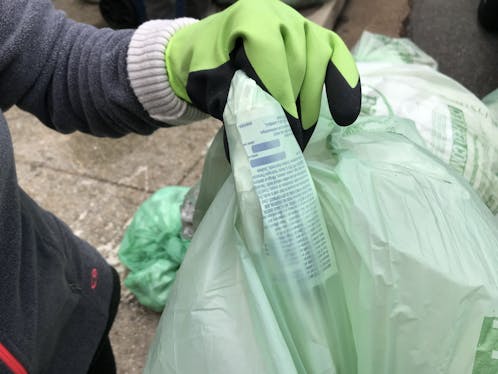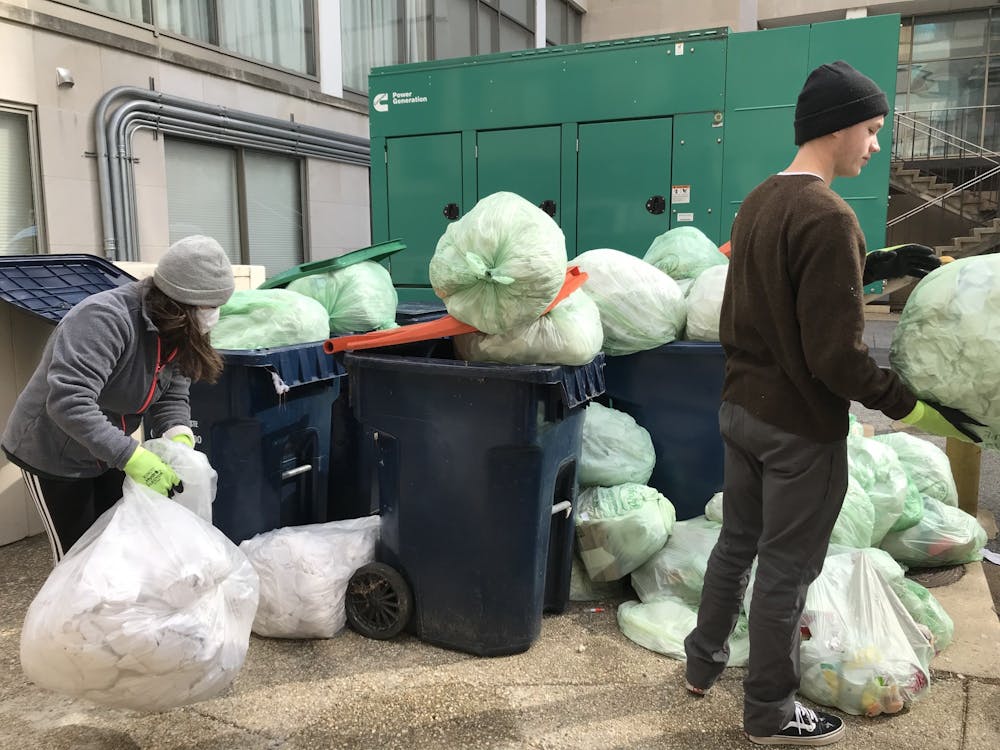Not all heroes wear capes — some wear waterproof gloves.
Jesse Cross, the University’s zero waste manager, oversees the Compost Crew program, which is a team of students who divert and sort campus compost from landfill. He follows the teams around to ensure the safety and smoothness of their mission.
Shelby Brown, a freshman in the School of Public Affairs, Natalie Oliver, a junior in the College of Arts and Science, and Randall Talbott, a senior in the School of Communication, make up just one of the crews of students who collect compost bins during the week.
“If we don’t have students, we don’t have a Compost Crew,” Cross said.
The process starts with the distribution of compost bins throughout campus. First, the teams line the empty bins with green, compostable bags.
Next, the bins are loaded onto a truck and driven off to various sites. From there, the team collects the bins that were filled in the previous shift.
During the Monday shift, the crew picks up full buckets from the previous Friday’s shift. The empty bins are then swapped for the full bins, which are then hoisted onto the truck.
While there are several public compost bins on campus, decorated with the orange-colored label, the Compost Crew focuses on the back of shop collections.
The main Compost Crew collection points include TDR, Subway, Starbucks, The Bridge Cafe, The Dav, Aloha Bowl and Campus Coffee and Tea. While Mary Graydon Center is also a collection point, the crew noted that there is usually little compost due to the “build your order” nature of the facility. On a Monday shift, students collect anywhere between 600 to 700 pounds of compost from these sites on campus.
While members of the team waited at a collection point, Brown brought out the playlist she created for the group. The playlist had a variety of music, from The Neighbourhood to the Arctic Monkeys.
“You got to find ways to liven it up,” Brown said.
After the team hits all of the collection points, they proceed to north campus, which includes residence halls like Leonard and Cassell. This is where the team sorts the orange compost bins found in communal spaces, like restrooms.
The University sends its compost to Prince George's County Organics Compost Facility. The facility has strict guidelines for what they take to compost — contaminated loads will be rejected, according to their website. The rules state that upon inspection, “contaminated loads will be rejected.”
According to Cross, too much contamination in AU’s compost would jeopardize its relationship with the facility, so the team has to be extra careful not to send any contaminated bags. Compost bags that are contaminated with other items, like plastic bottles or candy wrappers, have to be thrown away.
While the team cannot sort through the bags themselves, they analyze the contents of the compost bags from the outside. The team has perfected their sorting methods over the years. First, each bag is dropped — this method is called the “drop tactic,” according to Cross. If it hits the ground with a crinkle, crash or clang, the bag is then visually inspected. The bags that make these noises and are later found to be contaminated are trashed.
On the north campus site, Brown noted that there were about 50 bags total. After the sorting process was complete, about 15 to 20 bags were actually worthy of compost — the rest were too contaminated and were sent to landfill.
A 2018 Waste Management report noted that about 30 percent of organic materials, such as food scraps and compostable substances, end up in landfills. In comparison, out of all the north campus bags that were originally designed to be composted, only 30 percent were truly compostable.

Just one inorganic item ruins the bag, regardless of how many other compostable products are in there. Brown pointed out several items, like skincare products and slivers of food wrappers, that ruined bags full of compostable products.
The landfill bags were put into the waste handler. From there, the compost bags were hauled off to the next location: bins outside Letts Hall. The crew sorted more bags there. After the sorting, the compost products are taken to the compost bin outside Anderson and Centennial.
The compost buckets and bags are dumped into the composter to be hauled off sometime in the near future to the Prince George’s County facility. Next, the team washes out the green buckets to prepare for the next shift the following day.
These unsung heroes spend two hours a day, bearing the elements and various smells for the greater good of the University and the planet.





